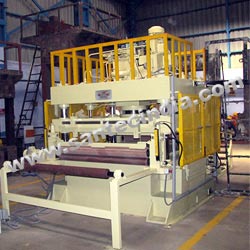|
Our Product Range
|
 |
 |
Hydraulic Presses - Articles & Resources
Defining the setup of
dual-pump control
The problem with valve control of cylinder motion is that it does its work
by converting (consuming) unused power to heat in the hydraulic fluid. The
advantage of valve control is that it accommodates differential rod and cap
end flows. Pump control, on the other hand, is efficient because it can
deliver power only when and where it is needed. The disadvantage is that it
works best with equal area actuators, and works not at all with unequal area
actuators.
 |
|
 |
Attempts have been made to use pump control on single—rod cylinders.
However, they incorporated some form of valving to deal with the unequal
flow, thus introducing an inefficiency. The simplified schematic shown here
depicts pump control without any valves, except those needed to control the
displacement of the two pumps.
This system is called the two—pump control method, and it uses a pump
on each end of a cylinder. Put simply, the two pumps have displacements that
are matched to the respective cylinder areas. To extend the cylinder, pump A
displacement increases to route flow into the cap end of the cylinder. At
the same time, displacement of pump B increases to absorb flow from the rod
end of the cylinder. Obviously, pump B's displacement must increase at
a lower rate than pump A's. This is the function of the block labeled
Ratioed stroke synchronizer.
Suppose the cap-end to rod-end area ratio of the cylinder is 2:l. The
synchronizer is a mechanism (electrical, hydraulic, or mechanical) that
causes pump A's displacement to be twice that of pump B's. If pump
A displaces 4 in. 3/ rev, pump B will displace 2 in.3/ rev. Clearly, the
pumps must be capable of over—center operation. The least expensive
means for displacement synchronization would be a simple mechanical linkage
between the two pumps. However, the most flexible solution would occur with
computer control.
Setting up the system
It would be impractical to try to set up the displacement synchronizer
before the system is built. The system can be tuned approximately during
final assembly and testing, but the final adjustment has to be done in the
system. The tuning of the synchronizer involves a slight misadjustment of
one displacement or the other (it doesn't matter which) to prevent
cavitation during system operation. The two pumps must work against each
other at all times, but only to a degree. This conflict elevates both
pressures, and the adjustment is aimed at ensuring that neither pressure
drops below atmospheric, thereby preventing cavitation during normal
operation.
How the system works
The circuit in the illustration has the equipment connected in a closed
positional servo loop. Preliminary adjustments will set the two
displacements at zero when the cylinder is unloaded and not moving. The two
cylinder pressures will both be zero, or nearly so. This results in a lack
of stiffness in the servo loop a condition that must be corrected. When the
cylinder is at rest, adjusting the offset control causes the displacement of
one pump to increase. If this is done to the rod end, fluid from pump B will
tend to retract the rod. However, if the piston rod actually does retract,
the position loop takes over and increases the displacement of pump A to
push the rod back.
Source: All Inputs From “Hydraulics & Pneumatics”
Magazines (A Penton Publication).




